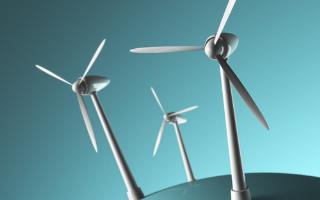
PORTLAND, OR - Portland's distinctive skyline has a dramatic addition. By the end of today, the graceful blades of four 45-foot-tall wind turbines are expected to begin spinning above the glossy new Twelve West Building, one of a handful of urban high-rises nationally that capture wind for electricity. The project, built downtown at Southwest 12th Avenue and Washington Street by sustainability leader Gerding Edlen Development Co., already has piqued international interest.
No one claims the turbines will shrink Portland's carbon footprint. They will produce about 9,000 kilowatt hours yearly - 1 percent of the building's electricity needs.
But they will be a much-needed learning lab for the possibilities of small, urban wind-power systems. And the details of their development and installation will be available to other developers and urban leaders.
"The bigger point is furthering the knowledge," said John Breshears, a principal with Zimmer Gunsul Frasca Architects.
Not all agree, however, that it's money well spent. Rather, critics say the investment would be better used improving building energy efficiencies or erecting turbine towers on windblown, rural sites and dedicating their energy to the new building.
"I call them 'kinetic sculptures,'" said Jerry Yudelson, a Tucson, Ariz., green building consultant and author who helped engineer the super-efficient OHSU Center for Health and Healing when he worked in Portland.
Yudelson's latest book, "Green Building Trends: Europe," details how the United States still lags behind Europe in energy-efficient construction.
"It's just a gesture, and it's fine if people want to make that gesture," Yudelson said of urban wind projects. "To me, there's a lot of ways to play the game. But the real game is to design a super-efficient, comfortable, healthy building."
Robert Packard, ZGF's managing partner, said the project is "trying something new. It's not a gimmick. Not only are we learning, but we can share it with the world, add to the body of knowledge that's out there."
Even before the turbines, the $137 million Twelve West Building aimed for the highest Leadership in Energy and Environmental Design certification - platinum - by the independent U.S. Green Building Council. Its energy-saving systems include motion-controlled lights and storm water capture that will process the water and return it to the building. An eco-roof garden will top the 22 stories, which will include residential, retail and office space.
"Before you look at renewable energy, you have to look at reducing the energy load on the building," said Craig Briscoe, an associate with ZGF.
Although wind turbines show up in a lot of architectural renderings - "We all think they look cool," ZGF associate partner Peter van der Meulen said with a laugh - they rarely become reality. Cities usually are built out of the way of heavy, constant wind, so the expected energy production doesn't pencil out to the costs of installation. And buildings aren't designed to hold rotating mechanical equipment for a lifetime.
Although Oregon is most known for its wind farms along the Columbia River, small wind systems on downtown buildings have been considered. But developers couldn't rationalize the predicted energy production.
The developer wanted to try again with Twelve West.
"We've completed six platinum and 26 gold LEED certifications and a couple dozen silver," said Mark Edlen, managing principal with the development firm. "We have a very strong belief that you have to innovate. The only way we've gotten where we are with platinum is to take some risks."
Breshears and Briscoe began a long, winding journey of wind power discovery. They enlisted Dutch consultant and wind researcher Sander Mertens to understand how Portland's wind flowed through downtown.
Then Tom Zambrano, an engineer behind the human-powered Gossamer Albatross, helped the team determine the shear plane of the building - where the turbines should be placed for the best wind.
The team chose the Skystream turbine, built by Arizona's Southwest Windpower Inc. one of the world's largest small-turbine producers.
Breshears and Briscoe will collect and share data on wind and power production from the turbines, which cost about $10,000 each to install.
The team compares its project to the early days of solar power. Eventually, solar technology became less costly and more effective. That, they say, could be the course of small wind projects.
"This is something that is very much in its infancy," Breshears said. "Our goal was to make this successful, not necessarily to get the most power."
Source: OregonLive.com